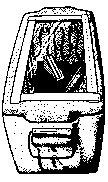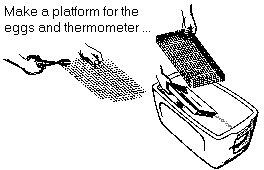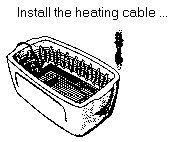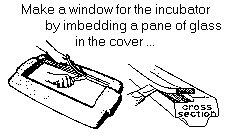Poultry
Constructing a Polystyrene Incubator

List of Materials
- Polystyrene ice chest (12-16" x 20-24" x 12"-15")
- Heating cable
- Micro-switch assembly (thermostat)
- Glass (approx. 10"x14")
- ¼" welded wire - hardware cloth (24"x36")
- Cake tin (9"x14"x1½")
- Thermometer
- Masking tape


Position the micro-switch assembly on one of the end walls so the center hole is about five inches below the top of the chest. With a pencil or other sharp pointed tool, make three holes in the chest for the temperature control bolt and two mounting bolts. Mount the switch by inserting the mounting bolt, add the washers, and tighten the nuts until the unit is firmly attached (Step 2). Insert the heating cable plug and the pilot light into the switch assembly before plugging in the lead cord. Check the unit to see if the pilot light glows and the heating cable warms up when the switch is activated. Both should be off when the switch is turned off. After checking the unit, remove the lead cord from the electrical outlet.

A window may be installed in the lid of the chest so you can see the eggs and chicks as they hatch. Center the piece of glass on the top of the lid and trace its outline with a marker. Remove the glass and draw a smaller rectangle inside the first with all sides parallel and 3/4 inch inside the traced glass rectangle. With a sharp knife, cleanly cut out the smaller rectangle and discard it. Then carefully cut around the outline of the glass on top of the lid to a depth of only one-fourth inch. Do not cut through the top.

Proper ventilation is provided by sixteen ¼-inch holes in the sides of the chest. Make the holes with a pencil or other sharp instrument. On each of the large sides of the chest, make a row of four holes two-inches from the bottom, and another row of four holes located three-inches from the top. The holes in each row should be four-inches apart.
Test the incubator by placing a shallow layer of warm water (100oF.) in the pan. Place the thermometer on the wire platform, put the lid on the chest, and plug in the lead cord. Turn the temperature control bolt until the pilot light goes on. Frequently readjust the control bolt until the desired temperature is reached. The pilot light and heating cable should shut off. Allow the unit to operate several hours before placing the eggs in it. This allows time to see how well the unit maintains a constant temperature.
Poultry
- Best Breeds of Chickens
- Breeds and varieties of chickens
- Causes for hens eating their eggs
- Causes of pecking and cannibalism
- Causes of Poor Feathering
- Chick removal from hatchery
- Commercial Poultry
- Constructing a Plywood Incubator
- Constructing a Polystyrene Incubator
- Construction of a still-air incubator
- Contents of chicken egg
- Culling Hens
- Disease and Pest Control
- Diseases of Poultry
- FAQ
- Feeds and Nutrition
- Fumigation and sanitation of hatching eggs
- Game Birds and Ratites
- General characteristics of Disinfectants
- Good management of egg producing hens
- Hatchery Management Guide for Game Bird and Small Poultry Flock Owners
- Hatching egg storage period
- How long to produce fertile eggs?
- Important incubation factors
- Incubation duration periods
- Incubation temperature requirements
- Management of egg producing hens
- Mistakes When Grilling Broilers
- Molting of laying hens
- Pesticides
- Pesticides Used for Control of Poultry Insect Pests
- Pipped eggs that do not hatch
- Quail Brooding Temperatures
- Quail Feed Formulations
- Quail Feed Medications
- Quail Feeding Programs
- Quail Pox
- Raising Backyard Chickens - Bio Security
- Reproduction & Incubation
- Sanitation of hatching eggs
- Sexing of day-old chicks
- Small Flock Management
- Solutions and Treatments
- Space needs of Bobwhite Quail
- Stages in chick embryo development
- Stimulating the setting instinct
- Temperatures recommended for brooding quail
- Testing incubated eggs for embryo development
- Time hens continue to produce fertile eggs
- Treatments for External Poultry Parasites
- Treatments for Poultry Parasites
- Trouble Shooting Failures with Egg Incubation
- Ulcerative Enteritis in Quail
- Washing of hatching eggs
- Why do hens stop laying eggs?
- Will all hens set on eggs?